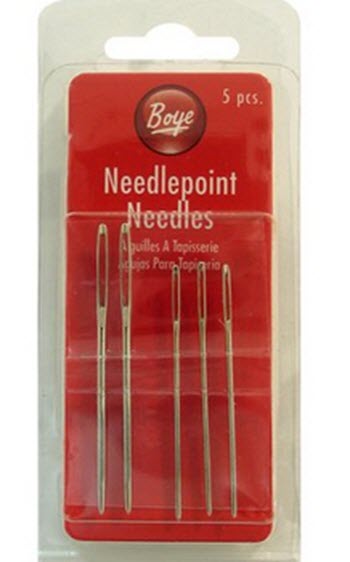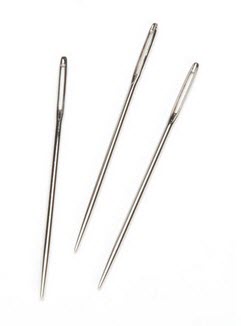On this page:
Using the right needles for a needlepoint project can be the difference between an enjoyable experience that yields a great end result and something barely started on that gets tucked away at the bottom of a drawer never to be resumed again. So, putting some effort into choosing the right needle is something I strongly recommend.
 Which type of needle should I use for needlepoint?
Which type of needle should I use for needlepoint?
Tapestry needle
In most cases, the best needle type for needlepoint work is the tapestry needle.
- A tapestry needle is blunt-tipped instead of sharp. When you are doing needlepoint on a typical needlepoint mesh, there is no need to use a needle with a sharp tip. Using a sharp tip will increase the risk of pricking your finger. Also, with a sharp tip, you can end up accidentally splitting one of the mesh threads or pushing the needle through needlepoint thread that has already been stitched onto the mesh.
- A tapestry needle has an elongated eye suitable for holding thick fibres or multiple strands of needlepoint thread.
Chenille needle
In some cases, you might need a chenille needle. With its sharper tip and a bigger eye, the chenille needle is generally avoided for needlepoint work, but can come in handy if you need to secure couched threads for surface embroidery work.
Which size should I use?
The ideal tapestry needle size depends on the canvas mesh size. Using the same size needle for each project regardless of mesh size is not a good idea. The larger the wholes in the mesh, the thicker a needle is recommended.
Before you commence on a project, push an empty needle through the canvas. (Select an inconspicuous spot for this, e.g. close to one corner of the mesh.) If the needle pushes the canvas threads apart when going through, it is too thick and you should try again with a finer needle. Keep going down in size until you find a needle that goes through without pushing the canvas threads apart. On the other hand, you also don’t want a needle that goes through the mesh with a lot of room to spare, since that needle is too thin to be ideal.
Labelling of tapestry needles
In the trade, tapestry needles are labelled with a number that will tell you how thick they are. The higher the tapestry number, the finer the needle. So, if you are looking for a thick needle, look for a low-numbered needle.
| Canvas mesh size | Recommended tapestry needle size |
| #8 to #10 | Size 16 |
| #10 to #12 | Size 18 |
| #12 to #14 | Size 20 |
| #14 to #18 | Size 22 |
| #22 to #24 | Size 24 to 26 |
Proper needle care for tapestry needles
Take good care of your tapestry needles and they will last longer and be more pleasant to work with.
If the needle looks discoloured, use soapy steel wool to gently clean it. Steel wool can also be used to fix a needletip that has started feeling rough or has a tendency to snag.
When you have cleaned a needle, rinse it well to get rid of any remaining soap. Dry off excess water and leave to air-dry. Do not put it back in airtight container or similar before it is completely dry.
Sharpening your needles with emery sand
Some pin cushions come with a little extra miniature cushion filled with emery sand. You push a needle into this sand to sharpen the needle top and smooth out any uneven areas along the length of the needle. Be careful not to sharpen it too much; as explained above, pretty blunt needles are ideal for needlepoint work in most situations.
